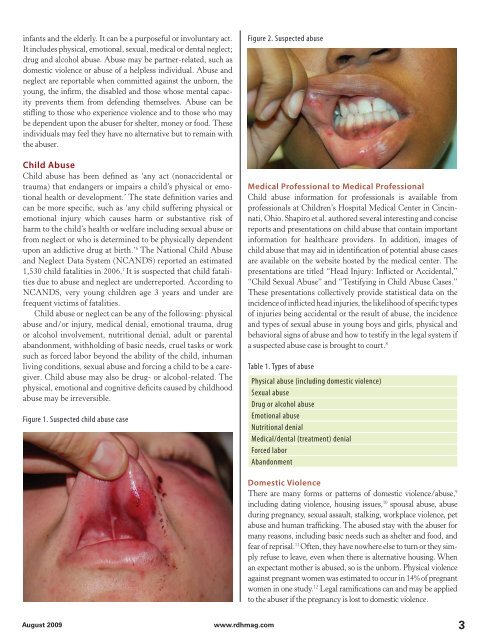Abuse: Mandated Reporting for Dental Professionals - IneedCE.com
Abuse: Mandated Reporting for Dental Professionals - IneedCE.com
Abuse: Mandated Reporting for Dental Professionals - IneedCE.com
Create successful ePaper yourself
Turn your PDF publications into a flip-book with our unique Google optimized e-Paper software.
infants and the elderly. It can be a purposeful or involuntary act.<br />
It includes physical, emotional, sexual, medical or dental neglect;<br />
drug and alcohol abuse. <strong>Abuse</strong> may be partner-related, such as<br />
domestic violence or abuse of a helpless individual. <strong>Abuse</strong> and<br />
neglect are reportable when <strong>com</strong>mitted against the unborn, the<br />
young, the infirm, the disabled and those whose mental capacity<br />
prevents them from defending themselves. <strong>Abuse</strong> can be<br />
stifling to those who experience violence and to those who may<br />
be dependent upon the abuser <strong>for</strong> shelter, money or food. These<br />
individuals may feel they have no alternative but to remain with<br />
the abuser.<br />
Child <strong>Abuse</strong><br />
Child abuse has been defined as ‘any act (nonaccidental or<br />
trauma) that endangers or impairs a child’s physical or emotional<br />
health or development.’ The state definition varies and<br />
can be more specific, such as ‘any child suffering physical or<br />
emotional injury which causes harm or substantive risk of<br />
harm to the child’s health or welfare including sexual abuse or<br />
from neglect or who is determined to be physically dependent<br />
upon an addictive drug at birth.’ 6 The National Child <strong>Abuse</strong><br />
and Neglect Data System (NCANDS) reported an estimated<br />
1,530 child fatalities in 2006. 7 It is suspected that child fatalities<br />
due to abuse and neglect are underreported. According to<br />
NCANDS, very young children age 3 years and under are<br />
frequent victims of fatalities.<br />
Child abuse or neglect can be any of the following: physical<br />
abuse and/or injury, medical denial, emotional trauma, drug<br />
or alcohol involvement, nutritional denial, adult or parental<br />
abandonment, withholding of basic needs, cruel tasks or work<br />
such as <strong>for</strong>ced labor beyond the ability of the child, inhuman<br />
living conditions, sexual abuse and <strong>for</strong>cing a child to be a caregiver.<br />
Child abuse may also be drug- or alcohol-related. The<br />
physical, emotional and cognitive deficits caused by childhood<br />
abuse may be irreversible.<br />
Figure 1. Suspected child abuse case<br />
Figure 2. Suspected abuse<br />
Medical Professional to Medical Professional<br />
Child abuse in<strong>for</strong>mation <strong>for</strong> professionals is available from<br />
professionals at Children’s Hospital Medical Center in Cincinnati,<br />
Ohio. Shapiro et al. authored several interesting and concise<br />
reports and presentations on child abuse that contain important<br />
in<strong>for</strong>mation <strong>for</strong> healthcare providers. In addition, images of<br />
child abuse that may aid in identification of potential abuse cases<br />
are available on the website hosted by the medical center. The<br />
presentations are titled “Head Injury: Inflicted or Accidental,”<br />
“Child Sexual <strong>Abuse</strong>” and “Testifying in Child <strong>Abuse</strong> Cases.”<br />
These presentations collectively provide statistical data on the<br />
incidence of inflicted head injuries, the likelihood of specific types<br />
of injuries being accidental or the result of abuse, the incidence<br />
and types of sexual abuse in young boys and girls, physical and<br />
behavioral signs of abuse and how to testify in the legal system if<br />
a suspected abuse case is brought to court. 8<br />
Table 1. Types of abuse<br />
Physical abuse (including domestic violence)<br />
Sexual abuse<br />
Drug or alcohol abuse<br />
Emotional abuse<br />
Nutritional denial<br />
Medical/dental (treatment) denial<br />
Forced labor<br />
Abandonment<br />
Domestic Violence<br />
There are many <strong>for</strong>ms or patterns of domestic violence/abuse, 9<br />
including dating violence, housing issues, 10 spousal abuse, abuse<br />
during pregnancy, sexual assault, stalking, workplace violence, pet<br />
abuse and human trafficking. The abused stay with the abuser <strong>for</strong><br />
many reasons, including basic needs such as shelter and food, and<br />
fear of reprisal. 11 Often, they have nowhere else to turn or they simply<br />
refuse to leave, even when there is alternative housing. When<br />
an expectant mother is abused, so is the unborn. Physical violence<br />
against pregnant women was estimated to occur in 14% of pregnant<br />
women in one study. 12 Legal ramifications can and may be applied<br />
to the abuser if the pregnancy is lost to domestic violence.<br />
August 2009<br />
www.rdhmag.<strong>com</strong><br />
3
















